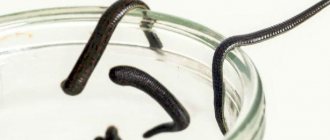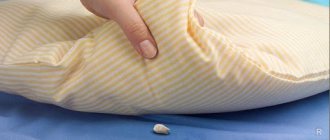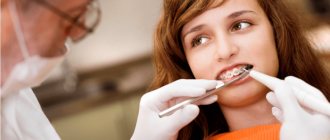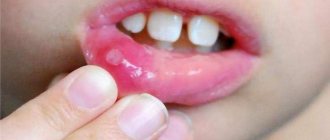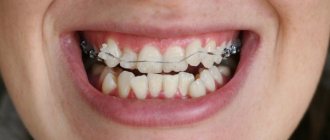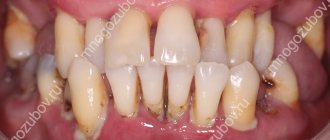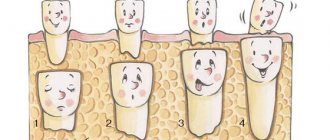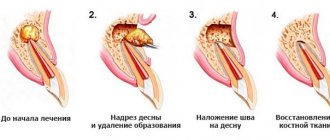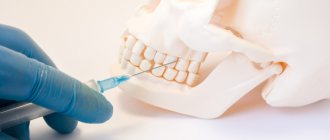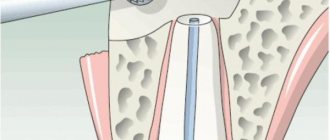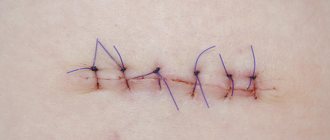An injection into the gum is a necessary measure that allows for effective treatment of teeth and periodontal tissues. Many patients are subconsciously afraid of injections in dental offices. It is because of fear that a timely visit to the doctor is delayed, which leads to the development of complications.
If we put aside prejudices and be objective, then the injection itself is not so scary. Moreover, modern treatment methods provide for all dental procedures to be carried out in a gentle manner.
Reasons for the development of pathology
Dentists divide the causes of periodontal disease into two groups - general and local.
The common causes of the formation of the disease include the presence of the following pathologies in the human body:
- hereditary or acquired systemic diseases;
- disturbances in the functioning of the endocrine system, leading to hormonal imbalances;
- chronic diseases of internal organs;
- damage to bone tissue;
- cardiovascular pathologies;
- complex mental disorders;
- avitaminosis;
- diseases of the digestive system;
- presence of bad habits - smoking, alcohol abuse.
Among the most common causes of local disease development are the following:
- acute or chronic injuries to periodontal tissues as a result of bruises, fractures, wearing unsuitable dentures, regular consumption of solid foods, and the presence of sharp edges of teeth;
- long-term absence of some elements of the jaw arch , resulting in improper distribution of the chewing load;
- malocclusion , leading to overload of some teeth;
- involuntary clenching of teeth - bruxism;
- infectious processes occurring in the oral cavity.
Patients with unsatisfactory oral hygiene are also at risk for developing the disease, as a result of which mineralized deposits and plaque regularly form on the teeth.
Contraindications to injections for periodontal disease
Injections to strengthen gums and teeth cannot be given in the following cases:
- acute form of inflammation and infectious processes in the oral cavity and the body as a whole;
- oral injuries;
- intoxication of the body, high temperature;
- individual intolerance to drugs used for periodontal disease;
- high blood pressure during the procedure;
- with caution - for cancer, diabetes, heart and vascular diseases.
The decision to perform the manipulation is made by the dentist based on the patient’s medical history, taking into account the expected benefits and possible risks and complications.
First signs
One of the difficulties in the timely detection of periodontal disease is the absence of pronounced symptoms of the disease at the initial stage of its development.
As a rule, the patient is not bothered by pain and bleeding gums, and the presence of a pathological process is detected after the beginning of the recessive transformation of the gum tissue.
Dentists focus on possible signals that may indicate the beginning of the development of a destructive process in periodontal structures:
- the appearance of slight itching and burning in the gums;
- the presence of mineralized plaque on the surface of the teeth, including in the soft tissue area;
- minor areas of gum recession measuring more than 1-2 mm.
As the pathology progresses, the symptoms become more pronounced:
- itching and soreness in the gum area occurs;
- obvious recession of soft tissues appears;
- the sensitivity of the roots increases as a result of their exposure;
- the distance between the teeth increases due to the resorption of bone partitions;
- tooth mobility occurs;
- Periodontal pockets filled with purulent contents may appear.
Periodontal disease is characterized by slow development - from the initial stage of the disease until the strength of teeth fixation is impaired, it can take from 10 to 15 years.
However, the sooner the pathology is identified, the faster and more effective the therapeutic process will be.
The purpose of gum coagulation in dentistry and the stages of the procedure.
Come here if you are interested in methods for determining periodontal indices.
At this address https://zubovv.ru/krasota-i-uxod/preparatyi/kak-mozhno-ukrepit-desnyi-v-domashnih-usloviyah.html we will tell you how to strengthen your gums at home.
Advantages and disadvantages of local treatment for bleeding and periodontal disease
Injections into the gums are designed for rapid delivery of medicinal substances to hard tissues. Aimed at eliminating the root cause of periodontal disease at the initial stage of the disease, namely bleeding. For injections into the gums, special syringes with the thinnest possible needle are used. They reduce pain and make the procedure minimally traumatic. Benefits of injections into the gums:
- strengthening gums during periodontal disease;
- improvement of metabolic processes;
- treatment and prevention of inflammatory processes in the gums;
- strengthening local immunity;
- restoration of the natural microflora of the oral cavity.
Injections into the gums should only be done by a dentist. Possible disadvantages of this method of therapy:
- can only be used in the initial stages, when the hard gum tissue is not irreversibly damaged;
- sometimes complications occur if the injection is given incorrectly or the oral cavity is not disinfected;
- people with hypersensitivity may experience severe discomfort;
This is interesting: Dental treatment under a microscope - indications and advantages of root canal treatment under a microscope
Proper preparation and, if necessary, anesthesia with local anesthetics will help to avoid problems.
Diagnostic measures
To identify periodontal disease, a comprehensive diagnosis is used, which makes it possible to differentiate the disease from other pathologies with similar symptoms.
First of all, the dentist clarifies the patient’s complaints and examines his oral cavity , during which he pays attention to the color and condition of the mucous membrane of the gums, the presence of tartar, and the raising of soft tissues in the area of the neck of the tooth.
The next stage is instrumental diagnostics, which involves the use of the following techniques:
- radiography - allows you to determine the condition of bone tissue, the presence of subgingival stone, the size of the alveolar ridges;
- rheoparodontography and Doppler ultrasound – methods for examining the quality of blood supply to periodontal tissues;
- polarography – helps determine the degree of oxygen saturation of the soft tissues of the oral cavity;
- Laser fluorometry involves the study of periodontal tissue using a laser.
In addition to examining the condition of the oral cavity, the patient is prescribed a consultation with highly specialized specialists - an endocrinologist, a cardiologist. This allows you to determine the cause of the disease and take measures to eliminate it.
Types of injections
Among the effective methods of combating periodontal disease, dentists highlight the introduction of certain medications into the gum tissue by injection.
This allows not only to anesthetize the affected areas of periodontal structures, but also to eliminate pathogenic microflora, reduce inflammation and activate local immunity.
Antitoxic serums
Serums injected into the affected areas of gum tissue contain specific antibodies. Their action is aimed at combating exotoxins produced as a result of the activity of pathogenic microorganisms.
The drugs have an anti-inflammatory and antimicrobial effect and help increase local antitoxic immunity.
The dosage and duration of administration of antitoxic serums is selected by the attending physician depending on the clinical situation, age and weight of the patient. Occasionally, specific side effects may occur - increased body temperature, swollen lymph nodes, joint pain .
Sclerosing drugs
This type of drug contains a mixture of chromium alum and oxygenated quininurethane. Sclerotherapy using injections into the mucous membrane helps strengthen the connective tissue of the gums, reduce the degree of swelling and loosening, as well as the formation of new bone structures.
Before starting sclerosing therapy, the dentist sanitizes the patient’s oral cavity and performs professional teeth cleaning to remove mineralized deposits.
The injection technique is as follows: using a thin needle, the solution is injected into each gingival papilla . The volume of drug administration depends on the condition of the soft tissues.
The duration of treatment is from 6 to 8 injections, the interval between which is usually 2-3 days.
Biostimulants
Biostimulating preparations are substances of animal or plant origin that have been subjected to various preservation methods.
According to researchers, such stimulants help increase the intensity of biochemical processes in the body. They also speed up metabolic processes and increase the regenerative abilities of soft tissues.
Most often, the main component of biostimulants used for periodontal disease is liquid aloe extract , which has an anti-inflammatory, strengthening and regenerating effect on oral tissue.
Contraindications to the use of biogenic stimulants are the presence of allergic reactions to the components of the drug , as well as high blood pressure and cardiovascular diseases.
Anti-inflammatory injections
To eliminate the inflammatory process that may accompany periodontal disease, a specialist prescribes antibiotic injections. Their selection is made on the basis of identifying the sensitivity of microorganisms to certain drugs.
The introduction of antibiotics can reduce pain, eliminate bleeding gums and eliminate the inflammatory process. At the same time, most antibacterial drugs have the ability to release toxins, so they are used only as part of complex therapy.
Vitamin complexes
Vitamin therapy is often carried out simultaneously with the main therapeutic measures. It helps to increase local immunity and protective functions of the body, stopping the atrophy of oral tissues.
For periodontal disease, injections of the following elements are used:
- vitamin A – increases the regenerative abilities of tissues, enhances metabolic processes;
- B vitamins – improve cellular metabolism and blood circulation, promote the formation of new tissues;
- vitamin C – increases the number of lymphocytes, has an immunostimulating effect;
- Vitamin E – has an antioxidant effect.
Glucose
Local application of glucose for periodontal disease helps reduce swelling of soft tissues, activate metabolic processes and improve the regenerative properties of the structures of the oral cavity.
The drug is injected into the gingival papillae every 2-3 days. In total, about 7-8 injections of a 50% glucose solution are required. As a rule, such injections are painless and safe, therefore they are often used as part of complex treatment.
Serum Filatov
This drug is a serum made from blood. It is used in the case of an inflammatory form of periodontal disease with a severe patient condition.
Filatov's serum can be used both for local applications using gauze swabs soaked in it, and as intramuscular injections. The course of treatment is 8-10 injections.
The drug is usually not administered under the mucous membrane, as it causes severe pain.
Lidaza
The enzyme preparation Lidaza is injected into the gum tissue during the development of dystrophic processes in the periodontium and the formation of inflammation, accompanied by gum hyperplasia.
The substance helps reduce swelling of soft tissues, increase their oxygen saturation, and stimulate metabolic processes.
How to perform the manipulation
Anesthesia is administered depending on the area of the surgical intervention on the gums. For minor manipulations, the dentist uses a 2% lidocaine spray, sprinkling it on the injection site or applying an analgesic strip (Dentinox, Kalgel), waiting for the first manifestations of the analgesic.
If there are no undesirable reactions (allergic, inflammatory), the doctor proceeds to pierce the already numb gums. The injection site should be as close as possible to the diseased tooth to minimize damage to nearby healthy tissue (the development of gingivitis or periodontitis in the future).
Having opened the ampoules with the contents (analgesic), the medical specialist draws several syringes and injects the medicine into the gums layer by layer, starting from the outer layers.
Types of local anesthesia:
- Infiltration anesthesia – used in the treatment of caries, during the removal of dental nerves.
- Conduction anesthesia is when a nerve bundle is blocked during the treatment of several teeth located close to each other.
- Intraligamentous anesthesia - injection of the drug into the peribuccal fold of the mucous membrane (in the treatment of painters and pre-painters).
- Injection of the drug into the bone of the upper or lower jaw. Performed when implants are implanted or molars are removed, in particular wisdom teeth.
- Involvement of the nerve trunk - anesthesia for large-scale dental procedures. It is carried out with the support of an anesthesiologist in a hospital setting.
We suggest you read What you need to know before surgery: is complex wisdom tooth removal dangerous?
General therapy
Treatment of periodontal disease is not limited to injections into the gum tissue. Complex therapy requires careful monitoring of the patient’s well-being and the prescription of auxiliary drugs to alleviate his general condition.
In some cases, the specialist has to resort to prescribing the following medications:
- painkillers , for example, Ketanov, Diclofenac, eliminate severe pain caused by puncturing the gums and administering the medicine;
- antipyretic drugs such as Nurofen, Analgin can quickly normalize elevated body temperature;
- antibiotics help eliminate the inflammatory process;
- antihistamines , for example, Suprastin, are used if an allergic reaction to the injection develops.
Each of the drugs is used only after prescription by the attending physician, in the dosage recommended by him. Self-administration of medications will not only not bring the desired result, but can also worsen a person’s condition.
The video presents methods of treating periodontal disease, including injections.
How to get rid of unpleasant feelings?
- If you are pathologically afraid of doctors, needles and injections, a common way to get rid of unpleasant sensations and provide “non-pain relief” is to refuse injections.
- If your gums hurt after an anesthesia injection, you do not need to inject the medicine, but only spray the area that needs pain relief. One of the most common painkillers is lidocaine. It is sprayed onto the surface of the gums.
- There is a practice of using folk remedies for pain relief after anesthesia. These are valerian leaves and clove essential oil. Apply the leaves or a cotton swab containing cloves to the sore gum to relieve pain.
Possible complications
Despite the excellent therapeutic effect, injections of drugs into the gums carry some danger.
Dentists note the following complications that may arise after injections:
- Formation of ulcers. The reason for their occurrence may be the use of insufficiently sterile instruments or the introduction of pathogenic microflora during professional teeth cleaning.
To eliminate the abscess, it is opened and the affected surface is further disinfected. - Pain in the injection area. Most often this is due to puncture of the gums and the individual sensitivity of the patient. To eliminate pain, the specialist recommends using local painkillers, for example, Solcoseryl ointment.
- Development of neuralgia. Sharp pain after injections may indicate that the trigeminal or facial nerve is being touched by the needle. In severe cases, the specialist prescribes painkillers to alleviate the patient’s condition.
See photos of patients with gum fibromatosis and read about the dangers of the pathology.
In this publication we will talk about why gums bleed during pregnancy.
Here https://zubovv.ru/lechenie/desnyi/epulis-kak-diagnostirovat-i-udalit.html we will talk about methods for removing epulis on the gums.
The main causes of pain after injection into the gums
The main cause of pain after an injection is damage to the gums by the needle. Pain appears when the action of the analgesic subsides. Normally, the patient is in pain for 2-3 days, and after surgery (more damage - several injections) up to 14-15 days.
If the pain does not subside, but on the contrary, it begins to hurt more severely, you need to consult a doctor again. Such manifestations indicate the presence of acute inflammation, edema, infection or manifestations of postoperative complications (cyst, abscess).
Possible causes of prolonged pain after surgery may be: injuries during surgery; inadequate analgesia (without calculating how long an anesthetic injection lasts or the wrong combination of drugs).
Useful tips
In parallel with the injections and taking medications prescribed by the dentist, the improvement of the patient’s condition with periodontal disease is facilitated by special care of the oral cavity and adherence to a diet aimed at fully saturating the body with beneficial vitamins and minerals.
Special care
To clean the oral cavity from plaque, food debris and pathogenic microorganisms, dentists recommend using a toothbrush with soft bristles.
This will prevent damage to soft tissue and eliminate bacterial plaque that accumulates on the surface of the teeth.
When choosing toothpaste, you need to pay attention to special therapeutic and prophylactic products, for example, Parodontax brand products.
The natural composition of such pastes allows you to improve the condition of the gum mucosa and prevent the development and spread of pathogenic microflora throughout the oral cavity.
Rinse
Rinsing with decoctions based on medicinal plants is highly effective in improving the condition of gums during periodontal disease.
The following recipes are the most popular:
- Cowberry. A tablespoon of dried lingonberry leaves is poured into a glass of boiling water and simmered over low heat for 20 minutes. Rinse the mouth with the strained and cooled broth 5-6 times a day.
- Oak bark. Two tablespoons of crushed oak bark are infused in a glass of boiling water for 20 minutes. After straining with this decoction, you can rinse your mouth every 2-3 hours.
- Soda. A teaspoon of soda is dissolved in a glass of warm water, and then used for rinsing 2-3 times a day.
Diet
Nutrition during treatment of periodontal disease should be rich in vitamins and minerals, so the following products are required in the daily diet:
- milk, cottage cheese and other calcium-containing foods;
- fresh vegetables and fruits, rich in fiber;
- dishes high in polyunsaturated acids - fish, vegetable oils, nuts;
- juices from vegetables and fruits high in vitamins.
It is better to avoid sweet confectionery products, caffeine-containing and carbonated drinks during this period. Instead, dentists recommend giving preference to purified water, green tea without sugar, and uzvar.
Rules of procedure
How to give an injection into the gum? The technology is as follows:
- The doctor visually examines the oral cavity and identifies problems. He needs to learn about drug allergies.
- During preparation, the puncture site is treated with an anesthetic gel or spray.
- After a few minutes, an anesthetic or drug is administered.
- The patient needs to slightly press the cheek with his hand on the side of the injection.
- “Freezing” is carried out after 10-20 minutes.
- If injections are prescribed to treat gum inflammation, the agent is injected along the perimeter of the jaw arch. Depending on the therapy, the number of punctures may vary.
This is how antibiotic injections are given into the gums or other medications are administered. The rules of procedure must be followed in any clinic, wherever the manipulation is performed. In this case, pain does not occur.
Expected effect
The effectiveness of periodontal disease treatment directly depends on the timeliness of the patient’s visit to the dental center. At the initial stage of the disease, the pathology can be eliminated with injections into the gums and auxiliary procedures. The duration of such therapy is usually 3-4 weeks.
If the patient comes in with advanced gum disease, the dentist will not be able to completely eliminate the pathology. In this case, therapy will be aimed at stabilizing the condition of the oral cavity structures and preventing further deterioration of the situation.
In what cases is pain relief required?
The dentist decides to give an injection into the gum if:
- the patient has caries that has covered a large area of the tooth or has penetrated deeply and requires removal,
- the patient has periodontal disease - a serious disease of the oral cavity,
- The patient requires tooth extraction, and this procedure is impossible to do without local anesthesia.
In a particular case, the purpose or recommendation of anesthesia is individual, since each organism is special. If the patient experiences unpleasant psychological sensations from the sight of the needle, and the hole in the tooth is small, the injection is not given.
Reviews
Timely detection of periodontal disease allows you to quickly and effectively eliminate the disease using drug injections into the gum tissue.
Continued adherence to medical recommendations and proper oral care will prevent bone tissue destruction and relapse of pathology.
If you have ever encountered a disease such as periodontal disease, share the features of its treatment using drug injections in the comments section.
If you find an error, please select a piece of text and press Ctrl+Enter.
Tags gums periodontal disease
Did you like the article? stay tuned
No comments yet
Online dream book
If you gave yourself an injection, this means that you will put your personal affairs above your responsibilities.
If it comes directly into a vein, be careful and prudent, strictly follow all the rules and regulations, otherwise you will create unnecessary problems for yourself and suffer serious punishment for your misdeeds and carelessness.
A dream in which you are given an injection is a warning that if you do not pay close attention to your well-being, you will face serious health problems.
If you dreamed that you gave yourself an injection - rest assured that nothing can force you to change your decision or fulfill your promise, so you should not be afraid of any difficulties or obstacles on your way, you will overcome them safely.
felomena /sonniki/u/ukol/» felomena
